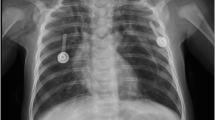Abstract
Endotracheal intubation obviously may be life-saving, but it may also lead to complications, including those related to damage of the airways. Superficial damage of the trachea at the site of the endotracheal cuff may trigger the formation of an obstructive fibrinous tracheal pseudomembrane (OFTP). Shortly after extubation, this clot, consisting of fibrin, leucocytes, and necrotic epithelium, can cause stridor due to adherence to the tracheal wall and obstruction of the airway. In most cases, the lesion is easily removed by rigid or fiberoptic bronchoscopy and virtually never leads to permanent damage. The study consisted of case series and review of the literature. This report describes a series of five adult cases and reviews all 19 other previously described cases. A careful analysis of all reported cases, however, did not highlight a simple predisposing factor or illness. It is important to consider OFTP in the differential diagnosis of stridor and respiratory insufficiency in the postextubation period.



Similar content being viewed by others
References
Deslee G, Brichet A, Lebuffe G, Copin MC, Ramon P, Marquette CH (2000) Obstructive fibrinous tracheal pseudomembrane. A potentially fatal complication of tracheal intubation. Am J Respir Crit Care Med 162:1169–1171
Divatia J, Bhowmick K (2005) Complications of endotracheal intubation and other airway management procedures. Indian J Anaesth 49:308–318
Sigrist T, Dirnhofer R, Patscheider H (1981) Rare complications following tracheotomy and intubation. Anaesthesist 30:523–527
Harbison J, Collins D, Lynch V, McNicholas WT (1999) Acute stridor due to an upper tracheal membrane following endotracheal intubation. Eur Respir J 14:1238
Takanami I (2003) Life-threatening stridor due to membranous tracheitis as a rare complication of endotracheal intubation: report of a case. Surg Today 33:285–286
Birch CW, Salkeld LJ (2005) A rare tracheal lesion. Paediatr Anaesth 15:73–76
Gershman A, Githaiga A, Mehta A (2006) Pseudomembranous tracheal stenosis. J Bronchol 13:82–83
Walter S, Gasthaus M, Schatz J, Koop I, Paschen HR (2007) Acute subglottic tracheal stenosis after resuscitation. Anaesthesist 56:790–792
Casoni GL, Coffa A, Gurioli C, Terzitta M, Gambale G, Poletti V (2007) A severe complication of short-term tracheal intubation. Anesth Analg 104:232–233
Carron K, Violon D (2007) Postintubation tracheal pseudomembrane. J Bronchol 14:210–211
van Dinther JJ, Boudewyns AN, Jorens PG, Van Marck V, Claes J, Van de Heyning PH (2009) Stridor due to a bridge-like subglottic stenosis in a 10-week-old male infant. Int J Pediatr Otorhinolaryngol 73:159–162
Rashkin MC, Davis T (1986) Acute complications of endotracheal intubation. Relationship to reintubation, route, urgency, and duration. Chest 89:165–167
Colice GL, Stukel TA, Dain B (1989) Laryngeal complications of prolonged intubation. Chest 96:877–884
Sandur S, Stoller JK (1999) Pulmonary complications of mechanical ventilation. Clin Chest Med 20:223–247
Newth CJ, Rachman B, Patel N, Hammer J (2004) The use of cuffed versus uncuffed endotracheal tubes in pediatric intensive care. J Pediatr 144:333–337
Sole ML, Penoyer DA, Su X, Jimenez E, Kalita SJ, Poalillo E, Byers JF, Bennett M, Ludy JE (2009) Assessment of endotracheal cuff pressure by continuous monitoring: a pilot study. Am J Crit Care 18:133–143
Benjamin B (1993) Prolonged intubation injuries of the larynx: endoscopic diagnosis, classification, and treatment. Ann Otol Rhinol Laryngol 160:1–15
Santos PM, Afrassiabi A, Weymuller EA Jr (1994) Risk factors associated with prolonged intubation and laryngeal injury. Otolaryngol Head Neck Surg 111:453–45919
Conflict of interest
None.
Author information
Authors and Affiliations
Corresponding author
Additional information
M. Lins and I. Dobbeleir have contributed equally to this work.
Rights and permissions
About this article
Cite this article
Lins, M., Dobbeleir, I., Germonpré, P. et al. Postextubation Obstructive Pseudomembranes: A Case Series and Review of a Rare Complication After Endotracheal Intubation. Lung 189, 81–86 (2011). https://doi.org/10.1007/s00408-010-9263-2
Received:
Accepted:
Published:
Issue Date:
DOI: https://doi.org/10.1007/s00408-010-9263-2




